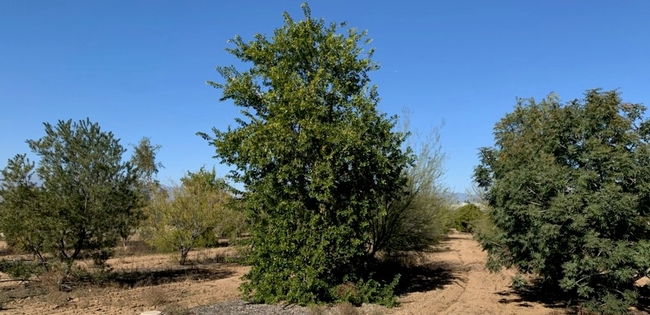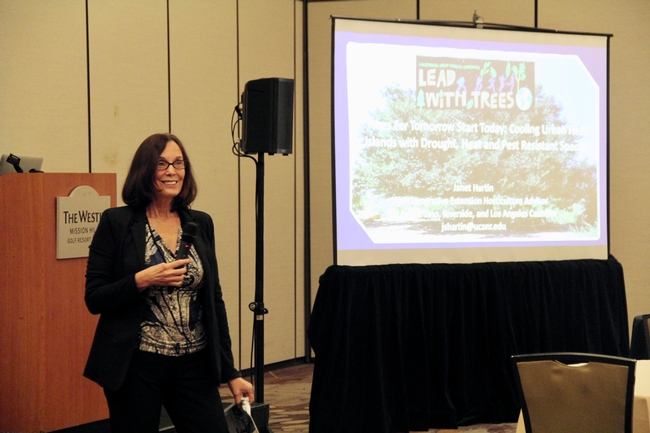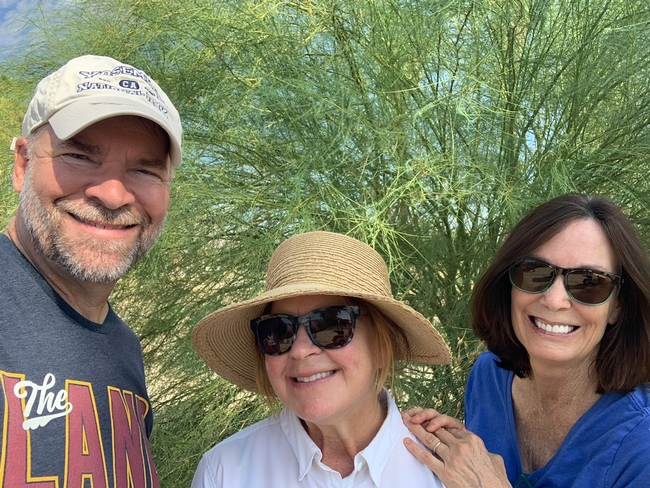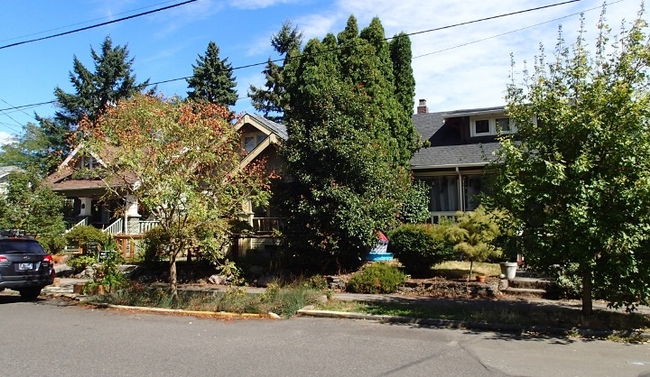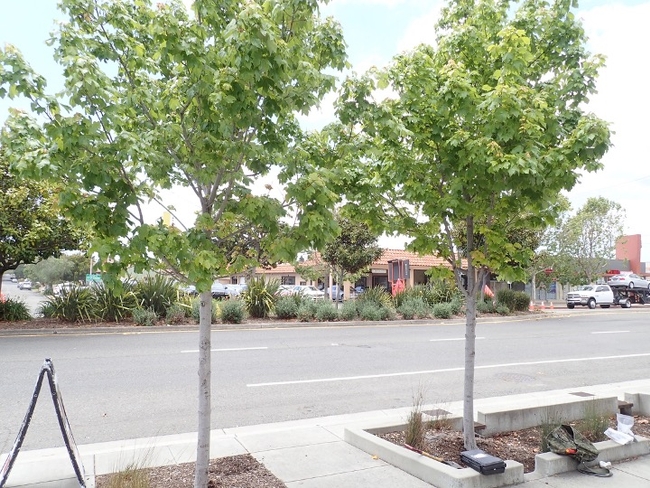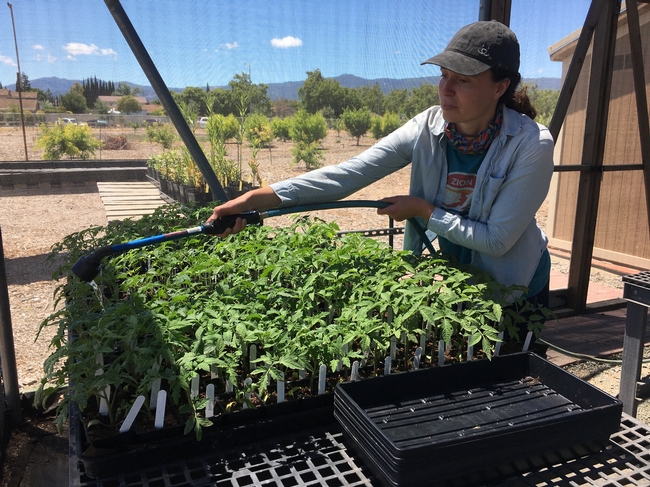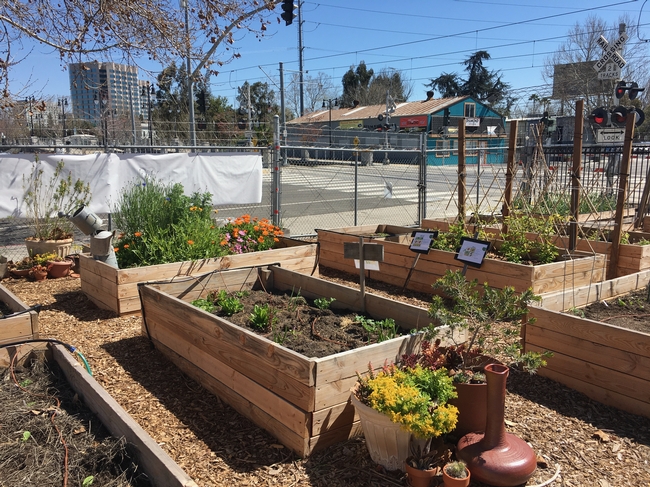Posts Tagged: urban
Now is the time to plant climate-ready trees, says UCCE researcher
In a drought-prone region like Southern California, working with Mother Nature is not only wise but necessary, according to Janet Hartin, UC Cooperative Extension horticulture advisor for Los Angeles, San Bernardino and Riverside counties, who studies climate-ready trees.
In 2020, Governor Newsom launched the California Climate Action Corps, empowering Californians to protect their communities from the impacts of climate change. Newsom's call to action emphasizes the need for long-term and sustainable solutions like Hartin's research, which urges Southern California to care for existing trees and plant new ones.
In collaboration with the U.S. Forest Service and other UC Cooperative Extension scientists, Hartin is amid a 20-year research study identifying trees suitable for California's different climate zones. Her work provides a comprehensive understanding of trees and their benefits related to human and environmental health, particularly as Californians navigate climate change's evolving challenges.
One of these concerns is urban heat islands. UHIs are areas in which heat is reradiated from paved concrete or asphalt surfaces. In cities covered in asphalt, like Los Angeles, average temperatures can become six degrees hotter than surrounding areas.
To reduce urban heat islands, she has been working with community organizations to plant trees. In March, for example, Hartin teamed up with the Inland Empire Resource Conservation District to increase tree canopy in the Inland Empire.
“We've collaborated extensively with her over the years, and we knew Janet had been developing a regionally scaled concept for connecting community members to climate-appropriate trees, alongside access to technical assistance from regional UCCE Master Gardeners to ensure long-term tree health and survival,” said IERCD District Manager Mandy Parkes.
Trees keep cities cool
To keep the city cool, some Los Angeles neighborhoods are repainting pavements with reflective coating. According to a 2020 study published in Environmental Research Letters, reflective coating can decrease pavement temperatures up to 10 degrees. As helpful as this is, augmenting urban landscapes to include heat-, drought- and pest-resistant tree species, whether native or not, can significantly reduce the impacts of urban heat islands too.
“Trees can cool impervious surfaces by 40 to 65 degrees,” Hartin said. During a 2021 study, in May and June Hartin discovered that unshaded asphalt could be more than 60 degrees hotter than shaded asphalt during late spring and early summer in inland and desert cities.
Other than providing shade, trees are effective at deflecting the sun's radiation and cooling the atmosphere through evapotranspiration. Given that they absorb and store carbon as well, trees lessen the impacts of pollution from fossil fuels.
“A well-tended mature landscape tree can absorb 40 tons of carbon over its lifespan,” said Hartin.
In a 2021 blog post, Hartin suggests trees be selected based on their adaptation to the “micro-climate” in each particular landscape, noting factors to consider like shade, proximity to buildings, space needs below and above ground, soil type and water source. She also recommends the Sunset Western Climate Zone maps for reference, noting that they are “more precise than USDA zones for our warmer climates.”
Based on the study with the U.S. Forest Service examining the performance of 12 species of underplanted but promising landscape trees at UC Riverside, favorable candidates include bubba desert willow and maverick thornless honey mesquite for their drought resistance, and red push pistache for its drought and heat resistance.
Tamara Hedges, executive director of UC Riverside Palm Desert Center and member of the Board of Directors for the Oswit Land Trust, agrees that trees are important in our fight against climate change:
“Through our partnerships with the UC California Naturalist and the Master Gardener Programs and many other nonprofits in the Coachella Valley, natural ecosystems are being protected and expanded and built environments cooled through the planting of appropriate tree species. These UC/USFS studies go a long way in identifying new underrepresented tree species."
General tips for planting
For California, planting in early fall through late winter provides ample time for trees to establish a strong root system before enduring the summer heat. Doing so also means that natural rainfall can fulfill water needs, as opposed to solely relying on irrigation systems.
Unlike newly planted trees, mature trees should be watered infrequently but deeply. Watering too often can reduce the level of oxygen in the rootzone and result in waterlogged soils prone to crown and root rots.
During the fall, trees only need about 15% of the water they would require in the summer. When watering, keep the tree trunk dry. Because the roots of the tree grow outward and are usually a foot deep into the ground, Hartin recommends watering the area around the trunk rather than the trunk itself. This will also help avoid water waste.
“Trees not adapted to the climate they're planted in and not receiving proper care are much more susceptible to invasive pests like shothole borers and diseases,” said Hartin. “Even the loss of one front yard tree can significantly reduce shade, increase the surrounding temperature, and diminish energy savings.”
How Termites 'Looking for Love' Landed in the News
What a year! Termites seem to be capturing the interest of more folks than usual. First, emeritus Cooperative Extension specialist...
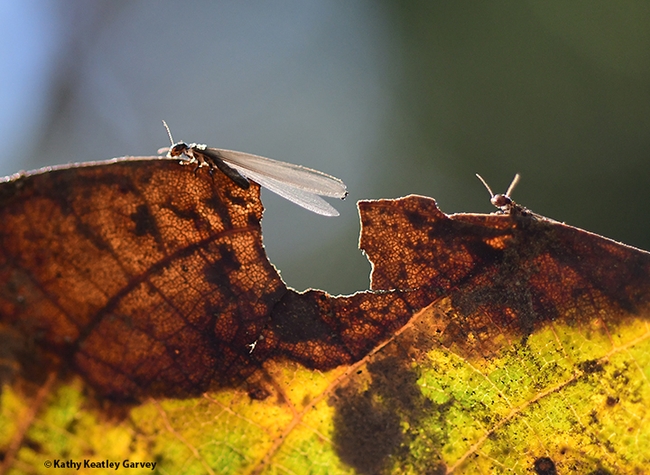
A winged termite ready for flight as another termite waits. This image was taken Oct. 27 in Vacaville, Calif.(Photo by Kathy Keatley Garvey)
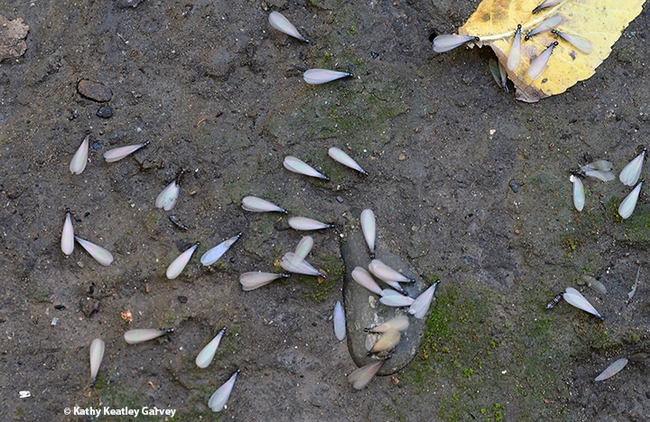
These subterranean termites have just emerged from the soil in a Buck Avenue yard, Vacaville, on Oct. 27. (Photo by Kathy Keatley Garvey)
The science of care for ‘calming and sublime’ trees in urban areas
The green leaves of the trees that line city streets soften the visual harshness of concrete and asphalt. Walking in the shade of their canopy, you may not think about how trees live in a small patch of soil surrounded by sidewalks and streets.
Behind every thriving street tree is science. Scientists evaluate trees to determine which species will grow well in a particular environment. Scientists study the best ways to protect the tree against pests and diseases. Scientists research how to prune the tree for the best performance.
“I think that the most overlooked and under-recognized value of trees is the subtle calming and healing effect that urban trees and natural green spaces have on people, and this effect is amplified once people become aware of it,” said Stephen Prée, environmental programs manager and city arborist for the City of El Cerrito. “While trees are calming and sublime, they are also busy at work removing pollutants from the soil and the air as they expel oxygen and moisture.”
“Our community uses our parks and natural areas as a vehicle for personal and community replenishment and revitalization. In the El Cerrito natural area, we see our community members relaxing in the shady ambience of a grove of trees, we see families or friends connecting with each other, we see volunteers working together to sustain native plant habitat,” said Prée, who is partnering with Igor Lacan, UC Cooperative Extension horticulture advisor for the Bay Area, on a study of streetside stormwater basins, or bioswales.
University of California Cooperative Extension horticulture advisors and specialists work with arborists, park superintendents, landscapers and many other professionals to support urban trees.
Trees can grow well in bioswales
Bioswales are built to contain stormwater that drains from homes and roads. When landscaped with trees, this green infrastructure provides several “ecosystem services,” says Lacan, such as filtering dust from the air, creating windbreaks, capturing stormwater runoff, muffling street noise, and providing habitat for birds and other wildlife. Some arborists are reluctant to plant trees in bioswales, concerned that the trees will fail if they don't have enough space to grow or get too much water in the winter and not enough water in the summer.
New research by Lacan shows trees can grow as well in bioswales as in other landscapes. To evaluate the performance of street trees, he monitored 23 tree species in 93 bioswales across five cities in the San Francisco Bay Area and in Portland, Ore., over five years.
Lacan's study showed that in the Bay Area trees grow well if they are irrigated in the summer, otherwise insufficient soil moisture may limit their growth. Importantly, he also found no evidence of waterlogging in the winter, thanks to quick drainage in the sandy soil. Although bioswale substrates tend to be composed of more sand than silt and clay, Lacan found the bioswale soils contain a comparable amount of plant nutrients to some other urban soils.
“Salinity isn't a problem unless de-icing salts are used,” said Lacan, who is part of the University of California Agriculture and Natural Resources or UC ANR. “It may become a problem where recycled water is used for irrigation, but routine soil tests are probably not needed unless the trees show symptoms of salinity or nutrient deficiency.”
A grant from UC ANR's California Institute for Water Resources enabled Lacan to start the bioswale study, and his successful research garnered additional funding from the U.S. Forest Service to continue the five-year study.
UC Master Gardeners take on BEaST
To share what he's learned, Lacan has enlisted UC Master Gardener volunteers in what he calls the Bioswale Education and Stewardship Training, or BEaST, project in Half Moon Bay. The UC Master Gardener Program is also part of UC ANR.
He is training UC Master Gardener volunteers to document trash and debris accumulation, and assess plant condition and soil texture, compaction, moisture and infiltration rate in bioswales. They report their observations via the smartphone app Survey 123 and a survey created by Lacan.
“That's the power of UC ANR,” Lacan said. “Thanks to the software license that UC ANR holds, we are able to use smartphones to collect data. It makes for a streamlined, comprehensive way to handle data and share the results with our San Mateo County partners who are supporting this project.”
The UC Master Gardener volunteers will in turn teach youth members of 4-H, another UC ANR program, and community members how to care for the plants in bioswales.
Monterey oak survey study
In Monterey County, Lacan is working with Justin Prouty, urban forester for the City of Monterey, on the Monterey Oak Survey Study. For the project, community members collect data on the condition of local oak trees.
“The most valuable aspect of this particular project is community awareness and engagement in their urban forest,” Prouty said. “I believe that having community members out simply observing trees and maybe noticing some of them for the first time is valuable in itself. My hope is the more people become involved in the care and advocacy for their urban forest, the more interest and funding will be directed towards its care.”
This project has helped Prouty and others in his department meet community members who would like to volunteer and advocate for maintaining the urban forest, he said.
“Another important piece is the access to UC Cooperative Extension staff who have insight into forest health and management in similar communities throughout the state,” Prouty said. “Over the past year or so that Igor and I have been working together, I have made connections with several people who have helped influence our strategy towards our own forest management.”
Projects such as these require partners who contribute different skills for the benefit of everyone involved, Lacan said. He explained that the County of San Mateo wanted to partner with him to inform its residents how to care for local stormwater infrastructure.
“For the BEaST project, we need a municipal agency partner in each city where the bioswales are located, then a funding source such as the San Mateo County Stormwater Program, and finally an outreach partner, which is our UC Master Gardeners,” Lacan said. “Without the comprehensive nature of UC ANR, none of this would happen.”
People should care about urban trees, said Prée, “Because the trees are improving the environment for all living things.”
Drought hurts urban farmers, too
Extreme drought is changing agriculture across California — and urban farming is no exception.
Many community farms and gardens cultivate land owned by city or county departments, schools and private landowners. Lucy Diekmann, a UC Cooperative Extension urban agriculture and food systems advisor in Santa Clara County, says that how those institutions handle rationing or surcharges set by water retailers makes all the difference for urban farmers. Diekmann co-authored a 2017 study looking at how urban agriculture in Silicon Valley was affected by the last period of extreme drought.
For example, priced-based water conservation strategies had very different outcomes depending on the landowner. Diekmann and her co-authors learned that three-quarters of Santa Clara County's community farms had their water bill paid by a project sponsor such as a nonprofit or school, and the sponsor absorbed the increased costs. On the other hand, one city-run community garden raised fees by 27% in one year to discourage water use. Some gardeners either left, dropped off the waitlist or chose smaller plots.
Diekmann and her co-authors point out that a major challenge for water management in urban agriculture is the lack of data. Many community farms and gardens don't have their own meters.
"We recommend that cities and counties subsidize the cost of meters, give financial support for installing watering systems that support conservation, and offer irrigation training," Diekmann said.
Because the water landscape is so uneven for urban farmers — usually in ways that benefit well-resourced groups — Diekmann and her co-authors also write that “affordable, consistent water prices for all UA (urban agriculture) users” must be part of all cities' urban agriculture policy portfolios.
You can read Diekmann's full study at https://www.tandfonline.com/doi/full/10.1080/13549839.2017.1351426.
About Those Urban Myths in Entomology
Professor Lynn Kimsey of the UC Davis Department of Entomology and Nematology and director of the Bohart Museum of Entomology,...
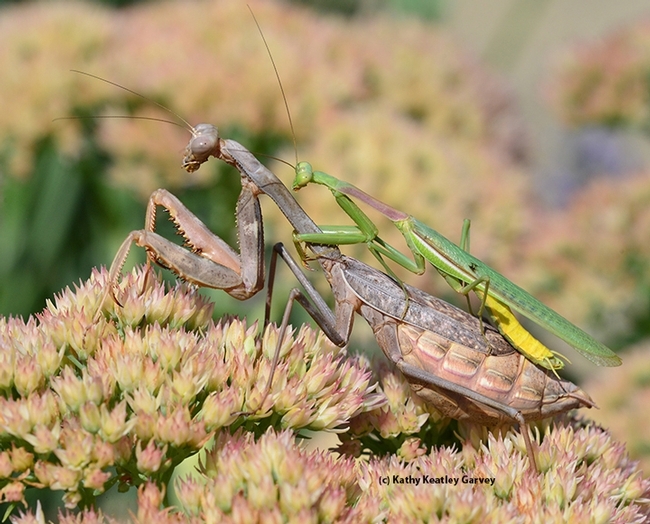
It's an urban myth that "Female mantids always eat males they mate with." Lynn Kimsey's response: "Only if the male isn't fast enough." (Photo by Kathy Keatley Garvey)
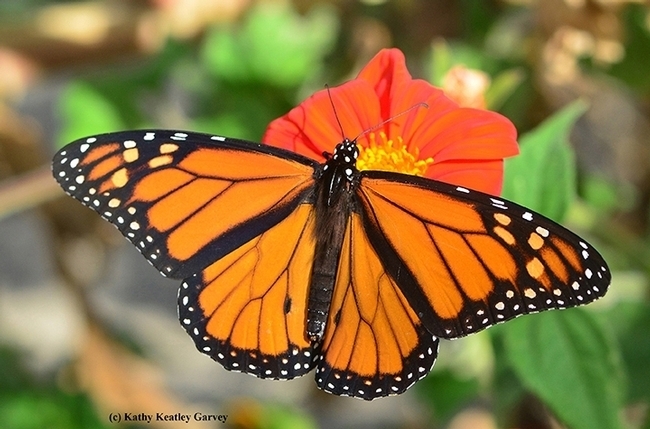
Urban myth: "Butterflies and moths can't fly if you rub the scales off their wings." Says Lynn Kimsey: "Not true, they can fly." (Photo by Kathy Keatley Garvey)


